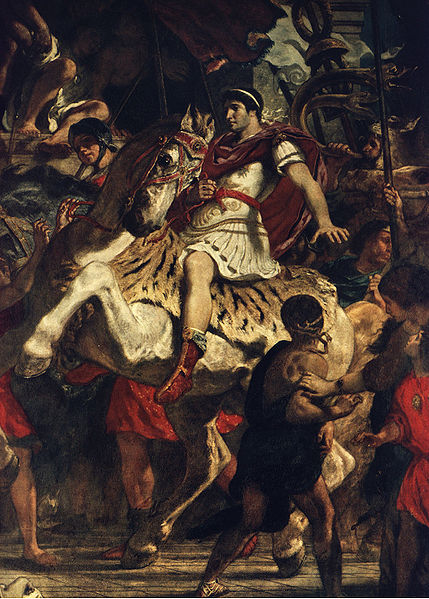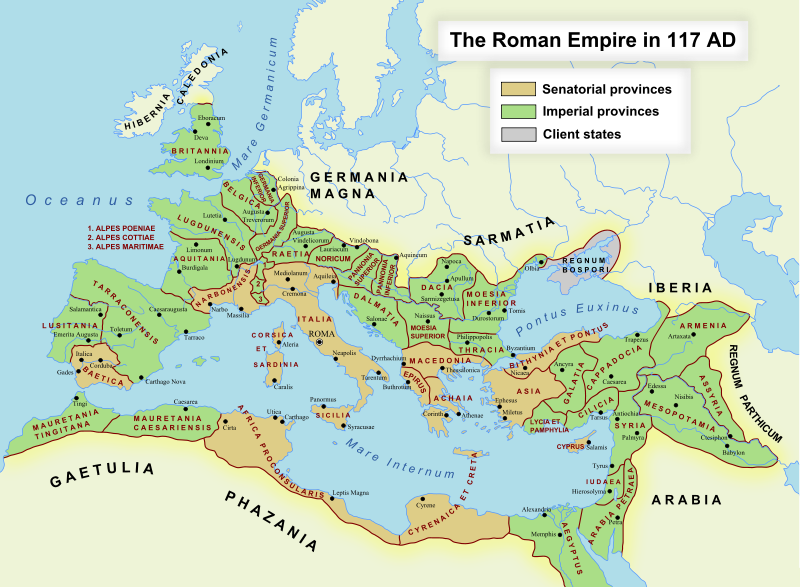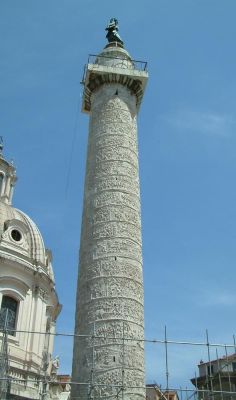<Back to Index>
- Physicist Edwin Mattison McMillan, 1907
- Writer Samuel Johnson, 1709
- Emperor of the Roman Empire Marcus Ulpius Nerva Traianus, 53
PAGE SPONSOR
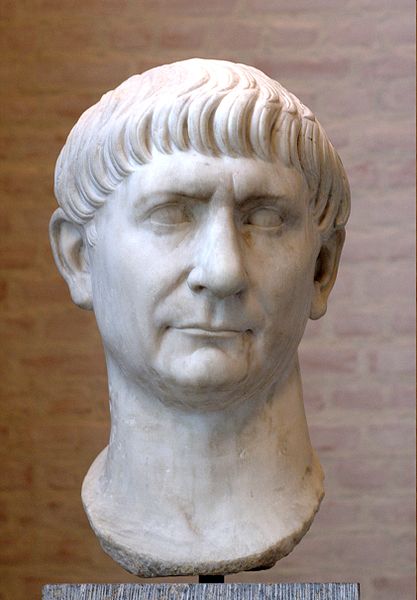
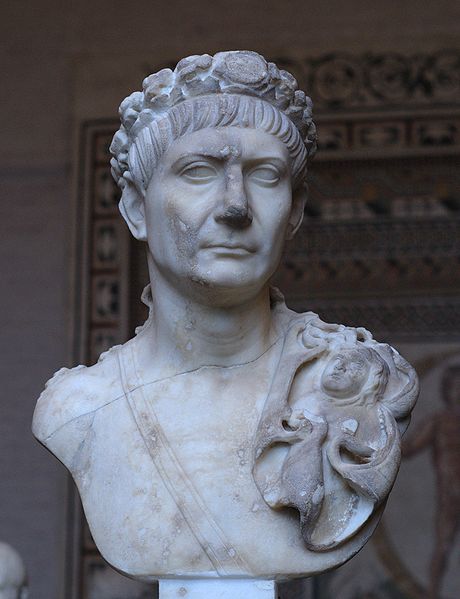
Marcus Ulpius Nerva Traianus (18 September 53 – 9 August 117 A.D.), commonly known as Trajan, was Roman Emperor from 98 to 117. Born into a non-patrician family in the province of Hispania Baetica, Trajan rose to prominence during the reign of emperor Domitian. Serving as a general in the Roman army along the German frontier, Trajan successfully put down the revolt of Antonius Saturninus in 89. In September 96, Domitian was succeeded by Marcus Cocceius Nerva, an old and childless senator who proved to be unpopular with the army. After a brief and tumultuous year in power, a revolt by members of the Praetorian Guard compelled him to adopt the more popular Trajan as his heir and successor. Nerva died on 27 January 98, and was succeeded by his adopted son without incident.
As a civilian administrator, Trajan is best known for his extensive public building program which reshaped the city of Rome and left multiple enduring landmarks such as Trajan's Forum, Trajan's Market and Trajan's Column. Early in his reign he annexed the Nabataean kingdom, creating the province of Arabia Petraea. His conquest of Dacia enriched the empire greatly — the new province possessed many valuable gold mines. His war against the Parthian Empire ended with the sack of the capital Ctesiphon and the annexation of Armenia and Mesopotamia.
His campaigns expanded the Roman Empire to its greatest territorial
extent. In late 117 while sailing back to Rome, Trajan fell ill and
died of a stroke in the city of Selinus. He was deified by the Senate and his ashes were laid to rest under Trajan's Column. He was succeeded by his adopted son Hadrian. As
an emperor, Trajan's reputation has endured — he is one of the few
rulers whose reputation has survived nineteen centuries. Every new
emperor after him was honoured by the Senate with the prayer felicior Augusto, melior Traiano, meaning "may he be luckier than Augustus and better than Trajan". Among medieval Christian theologians, Trajan was considered a virtuous pagan, while the 18th century historian Edward Gibbon popularized the notion of the Five Good Emperors, of which Trajan was the second. Marcus Ulpius Traianus was born on 18 September 53 in the Roman province of Hispania Baetica (in what is now Andalusia in modern Spain), a province that was thoroughly Romanized and called southern Hispania, in the city of Italica, where the Italian families
were paramount. Of Italian stock himself, Trajan is frequently but
misleadingly designated the first provincial emperor. Trajan was the son of Marcia and Marcus Ulpius Traianus, a prominent senator and general from the gens Ulpia. Trajan himself was just one of many well known Ulpii in a line that continued long after his own death. His elder sister was Ulpia Marciana and his niece was Salonina Matidia. The patria of the Ulpii was Italica, in Spanish Baetica, where
their ancestors had settled late in the 3rd century BC. This indicates
that the Italian origin was paramount, yet it has recently been
cogently argued that the family's ancestry was local, with Trajan
senior actually a Traius who was adopted into the family of the Ulpii. As a young man, he rose through the ranks of the Roman army, serving in some of the most contentious parts of the Empire's frontier. In 76 – 77, Trajan's father was Governor of Syria (Legatuspro praetore Syriae), where Trajan himself remained as Tribunus legionis. Trajan was nominated as Consul and brought Apollodorus of Damascus with him to Rome around 91. Along the Rhine River, he took part in the Emperor Domitian's wars while under Domitian's successor, Nerva,
who was unpopular with the army and needed to do something to gain
their support. He accomplished this by naming Trajan as his adoptive
son and successor in the summer of 97. According to the Augustan History, it was the future Emperor Hadrian who brought word to Trajan of his adoption. When Nerva died on January 27, 98, the highly respected Trajan succeeded without incident.
The
new Roman emperor was greeted by the people of Rome with great
enthusiasm, which he justified by governing well and without the
bloodiness that had marked Domitian's reign. He freed many people who
had been unjustly imprisoned by Domitian and returned a great deal of
private property that Domitian had confiscated; a process begun by
Nerva before his death. His popularity was such that the Roman Senate eventually bestowed upon Trajan the honorific of optimus, meaning "the best". It was as a military commander that Trajan is best known to history, particularly for his conquests in the Near East, but initially for the two wars against Dacia — the reduction to client kingdom (101
– 102),
followed by actual incorporation into the Empire of the trans - Danube
border kingdom of Dacia — an area that had troubled Roman thought for
over a decade with the unfavourable (and to some, shameful) peace
negotiated by Domitian's ministers. In the first military campaign c. March – May 101, Trajan launched a victorious attack into the Dacian Kingdom crossing to the northern bank of the Danube River and defeating the Dacian army near or in a mountain pass (Carpati) called Tapae (Second Battle of Tapae). Trajan's troops were mauled in the encounter, however, and he put off
further campaigning for the year to heal troops, reinforce, and regroup. During the following winter, King Decebalus launched a counter attack across the Danube further
downstream, but this was repulsed. Trajan's army advanced further into
Dacian territory and forced King Decebalus to submit to him a year
later. Trajan returned to Rome in triumph and was granted the title Dacicus Maximus. The victory was celebrated by the Tropaeum Traiani.
Decebalus, though, after being left to his own devices, in 105
undertook an invasion against Roman territory by attempting to stir up
some of the tribes north of the river against the empire. Trajan took to the field again and after building, with the design of Apollodorus of Damascus, his massive bridge over the Danube, he conquered part of Dacia in 106. After a fierce campaign (Second Dacian War), the Dacian capital, Sarmizegetusa Regia, was destroyed. Decebalus fled but, rather than being captured by the Roman cavalry, committed suicide, and his severed head was exhibited in Rome on the steps leading up to the Capitol. Trajan built a new city, Colonia Ulpia Traiana Augusta Dacica Sarmizegetusa, on another site than the previous Dacian Capital, although bearing the
same full name, Sarmizegetusa. Trajan also reformed the infrastructure
of the Iron Gates region of Danube. Built around 103 to 105, Trajan's Bridge,
or Pontes, is considered an architectural marvel, at 3,500 feet across.
He either commissioned the creation or enlargement of the road along the Iron Gates carved into the side of the gorge. Additionally, Trajan commissioned a canal to be built around the rapids of the Iron Gates. Evidence of this comes from a marble slab discovered near Caput Bovis,
the site of a Roman fort. It can be dated to the year 101 and
commemorates the building of at least one canal that went from the
Kasajna tributary to at least Ducis Pratum, whose embankments were
still visible until recently. However, the placement of the slab at
Caput Bovis suggests that the canal extended to this point or that
there was a second canal downriver of the Kasajna - Ducis Pratum one. Trajan
resettled Dacia with Romans and annexed it as a province of the Roman
Empire. Trajan's Dacian campaigns benefited the Empire's finances
through the acquisition of Dacia's gold mines. The victory has been
commemorated by the construction of the Trajan's Column, which depicts in stone carved bas reliefs the Dacian Wars' most important moments.
At about the same time Rabbel II Soter, one of Rome's client kings, died. This event might have prompted the annexation of the Nabataean kingdom,
although the manner and the formal reasons for the annexation are
unclear. Some epigraphic evidence suggests a military operation, with
forces from Syria and Egypt. What is known is that by 107, Roman legions were stationed in the area around Petra and Bostra, as is shown by a papyrus found in Egypt. The furthest south the Romans occupied was Hegra, over 300 km south-west of Petra. The empire gained what became the province of Arabia Petraea (modern southern Jordan and north west Saudi Arabia).
The
next seven years, Trajan ruled as a civilian emperor, to the same
acclaim as before. It was during this time that he corresponded with Pliny the Younger on the subject of how to deal with the Christians of Pontus,
telling Pliny to leave them alone unless they were openly practicing
the religion. He built several new buildings, monuments and roads in Italia and his native Hispania. His magnificent complex in Rome raised to commemorate his victories in Dacia (and largely financed from that campaign's loot) — consisting of a forum, Trajan's Column, and Trajan's Market still stands in Rome today. He was also a prolific builder of triumphal arches, many of which survive, and rebuilder of roads (Via Traiana and Via Traiana Nova). In 107 he devalued the Roman currency.
He decreased the silver purity of the denarius from 93.5% to 89% — the
actual silver weight dropping from 3.04 grams to 2.88 grams. This
devaluation, coupled with the massive amount of gold and silver carried
off after Trajan's Dacian Wars, allowed the emperor to mint a larger quantity of denarii than his predecessors. One notable act of Trajan during this period was the hosting of a three-month gladiatorial festival in the great Colosseum in
Rome (the precise date of this festival is unknown). Combining chariot
racing, beast fights and close quarters gladiatorial bloodshed, this
gory spectacle reputedly left 11,000 dead (mostly slaves and criminals,
not to mention the thousands of ferocious beasts killed alongside them)
and attracted a total of five million spectators over the course of the
festival. Another important act was his formalisation of the Alimenta,
a welfare program that helped orphans and poor children throughout
Italy. It provided general funds, as well as food and subsidized
education. The program was supported initially by funds from the Dacian
War, and then later by a combination of estate taxes and philanthropy. Although
the system is well documented in literary sources and contemporary
epigraphy, its precise aims are controversial and have generated
considerable dispute between modern scholars. Usually, it is assumed
that the program was intended to bolster citizen numbers in Italy.
However, the fact that it was subsidized by means of interest payments
on loans made by landowners restricted it to a small percentage of
potential welfare recipients (Paul Veyne has assumed that, in the city of Veleia, only one child out of ten was an actual beneficiary) – therefore, the idea, advanced by Moses I. Finley, that the whole scheme was at most a form of random charity, a mere imperial benevolence. In 113, he embarked on his last campaign, provoked by Parthia's decision to put an unacceptable king on the throne of Armenia, a kingdom over which the two great empires had shared hegemony since the time of Nero some
fifty years earlier. Some modern historians also attribute Trajan's
decision to wage war on Parthia to economic motives: to control, after
the annexation of Arabia, Mesopotamia and the coast of the Persian
Gulf, and with it the sole remaining receiving end of the Indian trade
outside Roman control – an attribution of motive other historians find absurd, as seeing a
commercial motive in a campaign triggered by the lure of territorial
annexation and prestige – by the way, the only motive for Trajan's actions ascribed by Dio Cassius in his description of the events. Other modern historians, however, think that Trajan's original aim was quite
modest: to assure a more defensible Eastern frontier for the Roman
Empire, crossing across Northern Mesopotamia along the course of the
river Khabur in order to offer cover to a Roman Armenia. Trajan
marched first on Armenia, deposed the Parthian appointed king (who was
afterwards murdered while kept in the custody of Roman troops in an
unclear incident) and annexed it to the Roman Empire as a province,
receiving in passing the acknowledgement of Roman hegemony by various
tribes in the Caucasus and on the Eastern coast of the Black Sea —
a process that kept him busy until the end of 114. The
chronology of subsequent events is uncertain, but it's generally
believed that early in 115 Trajan turned south into the core Parthian
hegemony, taking the Northern Mesopotamian cities of Nisibis and Batnae and organizing a province of Mesopotamia in
the beginning of 116, when coins were issued announcing that Armenia
and Mesopotamia had been put under the authority of the Roman people.
In
early 116, however, Trajan began to toy with the conquest of the whole
of Mesopotamia, an overambitious goal that eventually backfired on the
results of his entire campaign: One Roman division crossed the Tigris into Adiabene, sweeping South and capturing Adenystrae; a second followed the river South, capturing Babylon; while Trajan himself sailed down the Euphrates, then dragged his fleet overland into the Tigris, capturing Seleucia and finally the Parthian capital of Ctesiphon. He continued southward to the Persian Gulf, receiving the submission of Athambelus, the ruler of Charax,
whence he declared Babylon a new province of the Empire, sent the
Senate a laurelled letter declaring the war to be at a close and
lamented that he was too old to follow in the steps of Alexander the Great and reach the distant India itself. A province of Assyria was
also proclaimed, apparently covering the territory of Adiabene, as well
as some measures seem to have been considered about the fiscal
administration of the Indian trade.
However,
as Trajan left the Persian Gulf for Babylon — where he intended to
offer sacrifice to Alexander in the house where he had died in 323 BC —
a sudden outburst of Parthian resistance, led by a nephew of the
Parthian king, Sanatrukes, imperilled Roman positions in Mesopotamia
and Armenia, something Trajan sought to deal with by forsaking direct
Roman rule in Parthia proper, at least partially: later in 116, after
defeating a Parthian army in a battle where Sanatrukes was killed and
re-taking Seleucia, he formally deposed the Parthian king Osroes I and put his own puppet ruler Parthamaspates on the throne. That done, he retreated North in order to retain what he could of the new provinces of Armenia and Mesopotamia.
It was at this point that Trajan's health started to fail him. The fortress city of Hatra, on the Tigris in his rear, continued to hold out against repeated Roman assaults. He was personally present at the siege and it is possible that he suffered a heat stroke while in the blazing heat. Shortly afterwards, the Jews inside
the Eastern Roman Empire rose up in rebellion once more, as did the
people of Mesopotamia. Trajan was forced to withdraw his army in order
to put down the revolts. Trajan saw it as simply a temporary setback,
but he was destined never to command an army in the field again,
turning his Eastern armies over to the high ranking legate and governor of Judaea, Lusius Quietus, who in early 116 had been in charge of the Roman division who had recovered Nisibis and Edessa from the rebels; Quietus was promised for this a consulate in the following year — when he was actually put to death by Hadrian, who had no use for a man so committed to Trajan's aggressive policies. Early
in 117, Trajan grew ill and set out to sail back to Italy. His health
declined throughout the spring and summer of 117, something publicly
acknowledged by the fact that a bronze bust displayed at the time in the public baths of Ancyra showed him clearly aged and emaciated. By the time he had reached Selinus in Cilicia which was afterwards called Trajanopolis, he suddenly died from edema on August 9. Some say that he had adopted Hadrian as his successor, but others that it was his wife Pompeia Plotina who hired someone to impersonate him after he had died. Hadrian, upon becoming ruler, recognized the abandonment of Mesopotamia and restored Armenia — as well as Osroene – to the Parthian hegemony under Roman suzerainty – a telling sign the Roman Empire lacked the means for pursuing Trajan's overambitious goals. However,
all the other territories conquered by Trajan were retained. Trajan's
ashes were laid to rest underneath Trajan's column, the monument
commemorating his success.
Trajan was a prolific builder in Rome and the provinces, and many of his buildings were erected by the gifted architect Apollodorus of Damascus. Notable structures include Trajan's Column, Trajan's Forum, Trajan's Bridge, Alcántara Bridge, the road and canal around the Iron Gates, and possibly the Alconétar Bridge.
In order to build his forum and the adjacent brick market that also
held his name Trajan had vast areas of the surrounding hillsides
leveled. Unlike many lauded rulers in history, Trajan's reputation has survived undiminished for nearly nineteen centuries. Ancient
sources on Trajan's personality and accomplishments are unanimously
positive. Pliny the younger, for example, celebrates Trajan in his
panegyric as a wise and just emperor and a moral man. Dio Cassius added that he always remained dignified and fair. The Christianisation of Rome resulted in further embellishment of his legend: it was commonly said in medieval times that Pope Gregory I,
through divine intercession, resurrected Trajan from the dead and
baptized him into the Christian faith. An account of this features in
the Golden Legend. Theologians, such as Thomas Aquinas, discussed Trajan as an example of a virtuous pagan. In the Divine Comedy, Dante, following this legend, sees the spirit of Trajan in the Heaven of Jupiter with
other historical and mythological persons noted for their justice. Also
a mural of Trajan stopping to provide justice for a poor widow is
present in the first terrace of Purgatory as a lesson to those who are
purged for being proud. He also features in Piers Plowman. An episode, referred to as the justice of Trajan was reflected in several art works. In the 18th century King Charles III of Spain commissioned Anton Raphael Mengs to paint The Triumph of Trajan on the ceiling of the banqueting hall of the Royal Palace of Madrid – considered among the best work of this artist. "Traian" is used as a male first name in present day Romania – among others, that of the country's incumbent president, Traian Băsescu.
